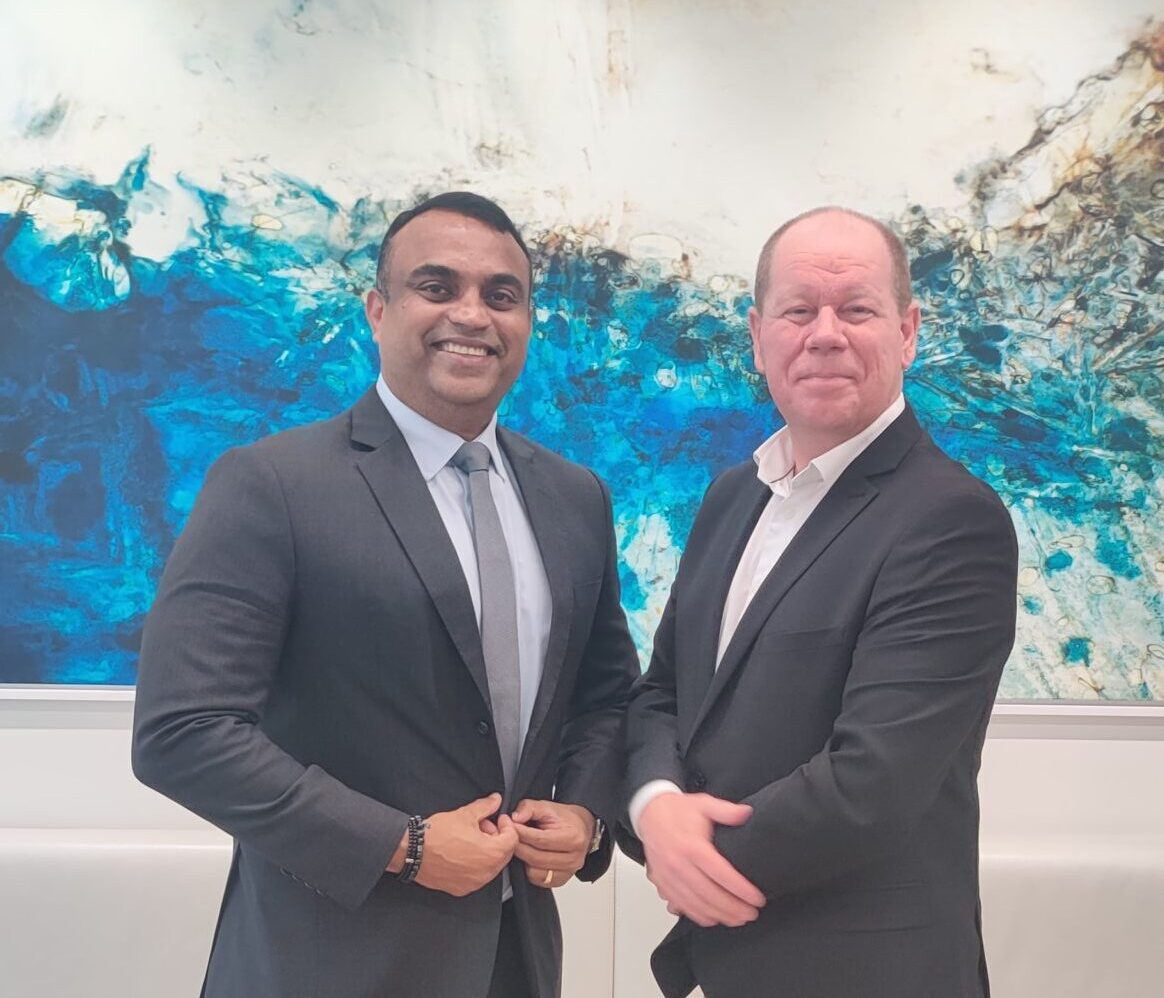Aruba, a Hewlett Packard Enterprise company is making strides and leading innovation in the world of IT networking. It believes that the most dynamic customer experiences happen at the Edge—an office, a hospital, a school, or at home. It’s anyplace work gets done and data is generated by users, devices, and things across the network. The company’s mission is to help customers capitalize on these opportunities by providing secure edge-to-cloud networking solutions. AI-based machine learning is being leveraged to deliver simpler, faster, and more automated networks that analyze data to help businesses and the world thrive.
CXO Insight ME sat down with Morten Illum, EMEA Vice President and Jacob Chacko, Regional Director – Middle East, Saudi & South Africa to understand what makes the company tick.
What do you see as the most important digital transformation trends today?
Morten: We have witnessed a lot of transformational topics over the last couple of years. Cloud computing has been a big trend which gathered momentum during the pandemic and is a cornerstone of a digital transformation strategy today. Security has become a top priority for CIOs today with the advent of the borderless enterprise. There is also a shift towards automation around processes, a big focus on AI and ML driven outcomes and the emergence of Software-as-a-Service IT consumption model.
But the most significant in my opinion is that of convergence – not just convergence of the network, but in general, the convergence of the whole IT estate – the operational environment, the sprawl, the reduction of administration tasks. All the things that are impacting companies as IT complexities increase. In this context, the network has started to become a transformational centre point.
Within HPE, we have multiple business units covering the IT estate – a server business, storage business, networking business, software business and financial services business. The vision we have as a company is the Edge-to-Cloud Platform as a Service. We are trying to help our customers on that convergence and transformation that they need to do on the digital side to create a new environment that serves as a platform for innovation. We see an increasing number of customers working with us to transform their networks from manually operated infrastructure to one that’s fully automated.
Can you explain the concept of Network as a Service (NaaS) and why is becoming increasingly popular in today’s context?
Morten: The simple answer is because our customers want to spend less time on operation and more time on innovation. As device counts grow, endpoints diversify, and connectivity demands increase, planning the network and keeping up with change can be overwhelming. What is needed is the flexibility of cloud agility, security, scale, compliance, automation and AI to help the business perform better. Network as-a-Service Brings Flexibility to the Edge. It includes data analytics, expanded telemetry, artificial intelligence, and automation – which combine to deliver critical efficiency gains in network operations. With network management increasingly complex in the new age of remote working, replacing manual interventions with advanced automation and analytics also provides increased visibility from a security perspective. Ultimately enterprises are increasingly favouring NaaS offerings as it allows them to outsource the hardware and software components of their networks to a partner to take on the more mundane tasks, enabling their employees to focus on mission-critical, business-enabling work. Overall, NaaS increases operational efficiencies which reducing costs.
And that’s why together with our partners, Aruba as a company is really betting hard on NaaS. And we have some very interesting capabilities to offer to the market.
What is so unique about Aruba’s NaaS offering?
Morten: We believe that the true value is the partner value chain that we have today. We don’t have an ‘Aruba only’ model. We deliver the framework as a foundation, and then depending on the customer’s unique requirements, our partners add bespoke services to our framework in order to deliver the required capabilities, working in close conjunction with Aruba and the customer. So, our NaaS solution is really about foundational NaaS capabilities. It is a framework coupled with the financial model and basic support and AI capabilities that we offer our partners who in turn deliver customized solutions to their end customers so that enterprises can consume the network as they consume the cloud – which is really what NaaS is.
HPE Aruba is positioned as a Leader in the 2022 Gartner Magic Quadrant for Wired and Wireless LAN Infrastructure. What are the various factors that have contributed to Aruba’s leadership position?
Jacob: It’s a matter of pride that for 17 consecutive years, we have been recognized as a Leader by Gartner for Wired and Wireless LAN infrastructure. I believe the driver behind this is our world class end to end Edge-to-Cloud solution portfolio. Our WiFi technology is one of the best in the industry. There are certain unique capabilities in our WiFi solutions like inbuilt GPS for example that other vendors in the market do not provide. Our CX switching platforms provide a very strong campus network solution. Aruba ESP (Edge Services Platform) is a next-generation, cloud-native architecture that enables you to accelerate digital business transformation through automated network management, Edge-to-Cloud security, and predictive AI-powered insights. All these market leading technologies, together with the right go-to-market strategy and a strong partner ecosystem across the globe have contributed to cementing our position as a Leader in the Magic Quadrant. And as Morten mentioned, we have yet another model to take to our customers – NaaS, where they can step away from the arduous operational tasks and focus on innovation.
The WAN Edge is the focal point for architecting a Secure Services Access Edge (SASE). Can you discuss Aruba’s strategy in this area?
Jacob: It all started with the acquisition of Silver Peak, the global SD-WAN leader, way back in September 2020. That today is the Aruba EdgeConnect solution which complements our Edge-to-Cloud portfolio. Our solution provides a secure network foundation for Zero Trust and SASE. It includes a best-of-breed SD-WAN solution paired with a next-generation firewall delivering unmatched quality of experience and advanced security. We have seen customers, including some of the MEA region’s top companies in transportation, education and public sector, react extremely positively to the technology. By empowering customers to use broadband connections to augment or replace their current MPLS networks, Aruba improves customer responsiveness, increases application performance, and significantly reduces capital and operational expenses by up to 90 percent. This value proposition resonates very strongly in the market.
One of our unique value propositions lies in our integration capabilities. Customers might already be on the cloud journey, working with cloud security vendors like Zscaler, Check Point, Palo Alto and others. Traditional SD-WAN vendors would suggest that they could do the security piece as well and advise the customer to rip and replace existing technologies. Aruba on the other hand integrates very strongly with other vendor’s technologies, so customers get the best of both worlds.
Morten: I think the SD-Wan market at the moment is hot. We acquired Silver Peak, because we thought it would complement our overall strategy. The fact that with the solution you are able to operate your connection to the cloud, to the user, at the edge, in a seamless way, with AI capabilities for a quicker and more efficient operational environment, is really a key differentiator.
In the Middle East and Africa there is a huge push towards digital transformation. And part of the digital transformation puzzle is the ‘security’ pillar, in which SD-WAN plays a key role. So that’s a part of the whole SASE storm that is coming to us, where customers are really interested in understanding how we can help them do more with less, but in a secure way.
How is Aruba leveraging the power of AI in its solutions?
Jacob: If you look at the top digital transformation trends, besides the cloud journey and NaaS which we discussed earlier, another very important aspect is how do you get outcomes out of AI and ML? Aruba ESP (Edge Services Platform) is layered around 3 building blocks – Connect, Protect, and Act. The ‘Connect’ piece is the WiFi and the switching. ‘Protect’ is how you build security around it. In this age of IoT, you’re talking about thousands of sensors that get latched onto the network. On an average, they say it takes not more than five minutes for a hacker to crack into an IoT network because of the number of endpoints. There is the need to have a good security framework to onboard these sensors into your network and ensure that policies are aligned to those sensors. This is what is being done on Aruba ESP. Now we come to the final piece ‘Act’. Within the networking industry, managing operational aspects has always been very reactive in nature. With AI and ML, there is a distinct shift now towards being proactive. To give you an example, every mall has a WiFi infrastructure that shoppers and staff connect to. With the WiFi network responding to connection requests, there is less network capacity to support the store’s employees and guests, resulting in a poor user experience. Aruba AIOps has the ability to detect this anomaly and determines the difference between someone passing by and a legitimate user, offering prescriptive recommendations that prevent this from happening again. After incorporating the recommendations, retailers can get insights that eliminate 98% of the network traffic caused by people walking by the store. That’s the beauty of AI. And that’s what has been built into the Aruba ESP solution.
Cloud-Managed Networking has become an important pillar of an organization’s digital transformation strategy especially in the context of the hybrid workplace. What role does Aruba play in this area?
Morten: We’ve been operating networks managed by the cloud or managed from the cloud for a very long time. Our solution Aruba Central is a cloud-based networking solution with AI-powered insights, workflow automation, and edge-to-cloud security that empowers IT to manage and optimize campus, branch, remote, data center, and IoT networks from one dashboard.
The real trick when it comes to cloud-managed networking is the inbuilt AI/ ML capabilities. From analysis of metadata of hundreds of thousands of customers that are using Aruba Central, we can advise customers on how best to set up their network, give them network health recommendations and even go one step ahead of competitors by helping network operators resolve issues by recommending solutions. Usually when there is a network failure, the operator has to wait for the issue to repeat, make sure he collects the network packets and then figure out what happened. This process could take minutes or hours and sometimes even days depending on when the repeat failure happens. Aruba Central on the other hand immediately understands that there is something happening and automatically starts data extraction, so the operator is presented with all the documentation and facts. In addition, Aruba Central recommends a solution. This short circuits the time to resolution. In many cases the system even advises what changes and tunings to make so that problems like this will not occur in future. This is the real benefit of cloud managed networking. Not just that we’re operating from the cloud, but we are actually using it to provide real value to the IT department.
During GITEX 2022 recently, the company launched its first Cloud Instance in the UAE. Can you elaborate on this and also tell us how the market has reacted to this launch and what successes are you seeing?
Jacob: This was one of the biggest launches of the year. We have witnessed the fact that customers want to embark on a cloud journey, but there are apprehensions when it comes to data privacy. And that’s when we decided to invest in the UAE. We set up an in-country cloud instance to cater to customers within the region. The Cloud instance provides in-country data residency and enables local enterprises to maintain proximity to their data. We have had a phenomenal response because this is exactly what the customers were looking for and this has certainly helped them push ahead with cloud adoption as part of their digital transformation initiatives.
What are Aruba’s plans in terms of business strategy and innovation in the next 2 to 3 years?
Morten: GROW!! We currently have the strongest portfolio we have ever had in our history, and we have a market that is very receptive to our vision. We have full respect for the competitive landscape, but at the same time believe that we have unique value to offer. Our technologies help automate the network and we also deliver the network in the way customers want it – they can buy it and run it, or they can buy it and we run it or they can get it As-a-service and we do everything for them.
The Middle East and Africa market represents tremendous potential for our company and Jacob, and I will take the lead together in driving business, converting more customers and cornering a larger market share.
Jacob: We are very grateful to all our customers and partners in the MEA region. Today we see a distinct move towards outcome driven discussions, which is a sign of maturity of the market. It is no longer about telling customers that we provide networking products. Rather, it’s more about what business outcomes organizations in every industry can drive with Aruba. We have RFPs today that at a high-level look like networking RFPs but talk about building a highway for IoT. This transformation that we are currently witnessing in the networking industry is overwhelming. And it’s absolutely welcome. It completely resonates with our strategy, and we are well poised to assist customers in their digital transformation journey.










Discussion about this post